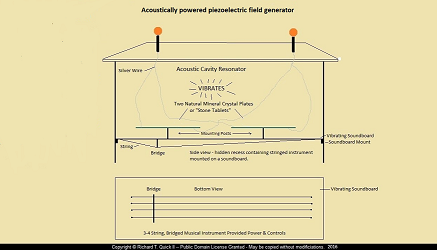Nikola Tesla's Cymatic Research and Development
A full understanding of this section requires some background knowledge in Fractals and Cymatics. These topics are outlined Here, but it is very helpful to search these topics online, read some background, and watch a video or three. I recommend material on cymatics by John Stuart Reid, and I linked to a video presentation of his below.

517,900

Steam Powered Isochronous Acoustic Oscillators & Generators
511,916
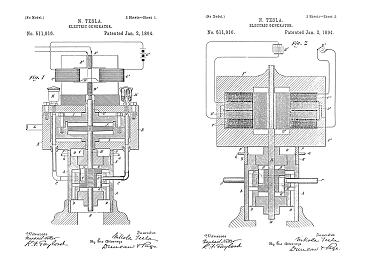
Electric Generator - Aug 19, 1893
514,169
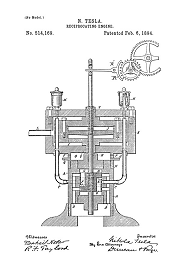
Reciprocating Engine - Aug 19, 1893

Tesla filed application on the above technology in 1893, but a practical assessment of his alternating current motor development, in particular high-speed magnetic lag, motors indicates that Tesla had the same or similar devices in the laboratory some years before these patent applications were filed. The development of high-energy lag motors requires high-accuracy measurements of the magnetic lag. The engine shown in 514,169 is driving clockwork.

The above engine is a version of 511,916, adapted to drive a coil in a powerful magnetic field in order to produce isochronous current pulses used for timers, strobes, and frequency stable rotating magnetic fields. This particular design was developed into a large 2 or 4-phase generator used as a frequency stable power supply in the lab. Click the image for a much higher resolution.
While this line of research began with the need for very accurate measurements and the development of the required instrumentation; it went on into advanced cymatic studies on shaker tables: using powders, liquids, uniform particulates like plant seeds, even laboratory visitors were vibrated: and large 2 and 4-phase steam driven electromagnetic generators rated at 10 horsepower to produce frequency stable rotating magnetic fields used as the time control signal to prevent frequency drift in linked, synchronous, rotational, electromagnetic networks.
The synchronous operation of brushless induction motors is a key aspect of Tesla's polyphase system. A motor that rotates at a specific rate can be used to drive clockwork and keep time for example, but this means that the alternating current coming from the generator has to be completely frequency stable: either a pure sine wave that is free of lagging, overspeed, and drifting between the two in oscillations (which is impossible to obtain from a line-shaft): or perfectly timed pulses from an isochronous generator. At very low frequencies, like those used in the global power grids, these problems are not too difficult to deal with mechanically, even back in the 1890's, and nobody then other than Tesla had technology that depended on _absolute frequency stability_. But as frequencies increase in both applications for power delivery and in applications for transmission of intelligence, this timing becomes more and more critical.
In the end, Tesla was forced to invent, develop, and apply, isochronous generator technology in order to produce frequency stable sine waves. The electric circuit controllers used to switch high-voltage capacitors in large Tesla transmitters were powered, and timed, using the isochronous generator technology detailed on this page. But even prior to this application, powerful isochronous generators were used to turn high speed synchronous motors, and these motors were directly shaft coupled to 447,920 --&-- 447,921 in order to produce a much higher frequency, pure sine wave, output signal that did not drift.

Above: US Patent 511,916 - Electric Generator - This machine was used to power Tesla patented 2-phase motors in isochronous/synchronous operation for wireless research. It was located in the 33-35 S. Fifth Ave. laboratory that was consumed by fire. Tesla found that it was so important to his research he invested an enormous sum of money in a much larger, more complex, more advanced, and much more powerful machine (below) - Martin also covers this machine as it was part of Tesla's lecture on Mechanical and Electrical Oscillators at the 1893 World's Fair.

The larger machines are also suitable power supplies for experiments in wireless energy transmission. By comparing the effective range of various wireless transmitters using different wave forms and energy coupling techniques, Tesla determined that the most effective transmitter produced a sine wave output, with the frequency stability of an isochronous generator. This frequency stability and lack of drift is imperative in wireless communications whereas it is only highly desireable in a low frequency network designed to power lamps and motors: because of motor driven clocks, and motors designed to operate on the principal of magnetic lag which depends on precise waveform timing for efficiency.
Because of the power of these machines, the pulses produced were used in many, many experiments in harmonics. Tesla observed that exciting tightly electromagnetically coupled coils with isochronous generator pulses produced frequency stable sine waves suitable for long distance communications. He discovered the same principal works when you use a perfectly timed capacitor discharge to excite the coils.

Click for higher resoution

514,169 - Reciprocating Engine

Tesla was a clock maker. He used U.S. Patent 514,169 to drive clockwork, and the clock rotation was used to turn circuit controllers to trigger strobe lights, among many other things. Diagrams a and b above are front and side sketches of such a circuit controller.


This reciprocating engine technology also has practical applications as the source of mechanical vibrations for things like ground penetrating radar, sonar, and sonic communications links. It has been discussed as the technological base for "Telegeodynamics" or "force action at a distance" through high-energy ground-transmitted acoustic waves; but the power supplies, side effects, and expense, do not appear to make these ideas very practical as "weapons systems".
However, communications systems using bedrock and/or bodies of water as the transmission medium for mechanical vibrations at acoustic frequencies are not only possible, I can plausibly document this application in the historical record, and the US Navy currently exploits this technology in multiple ways: communications, detection, mapping and location systems. The transmitter technology used by the US Navy are of both types: electromagnetic and mechanical vibrational; and logically they either have systems, or they are developing systems, that combine both elements into a single transmitter unit.
But it is important to understand that the study of acoustic mechanical cymatics is a very ancient science, older than recorded history, as old as music and the construction of musical instruments by humans. Tesla was developing an acoustic technology that had been well studied and applied by ancient cultures, and while humans in the past primarily created and observed the effects of mechanical acoustic vibrations, or sonic waves, Tesla advanced deeply into acoustic electromagnetic vibrations. These electromagnetic waves propagate at, or near, light speed, but the propagation mode is nearly identical to mechanically produced waves of this type and frequency range; along bedrock and through bodies of water, moving along the surface and subsurface as it travels over the horizon, following the form of the Earth's crust. These are surface type waves with a subsurface geometry, the lower the frequency of these waves, the longer the wavelength grows, and the greater depth of penetration of the subsurface component. At Extremely Low Frequencies (ELF) using electromagnetic transmitters, the US Navy is able to communicate one-way with operational submarines at the bottom of the ocean using this technology.



Fig 185 comes from Tesla's lecture before the Franklin Institute, February 1893. Fig 7 below it comes from an article Tesla wrote for Electrical Experimenter, May 1919 and shows the mechanical analog of Figure 185: a tuning fork power supply or mechanical "modulator", in the place of Tesla's patented high-frequency alternator 447,920. The principal of operation throughout is the same as for the tin-can telephone, which in order to work properly requires a heavily waxed string and a thin flexible diaphram.
Also See: The Problem of Increasing Human Energy - Diagram c
447,920
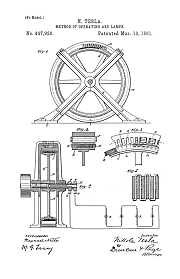
Method of Operating Arc Lamps - Oct 1, 1890

US Patents: 447,920 - 447,921 - 405,858 - 424,036


The above device, shown with and without the coil and steam feed line, is a small electro-mechanical oscillator initially used to provide instrumentation signal for obtaining measurements. With the coil in place and energized with a DC current the frame became a DC electromagnet. Inside the frame between the magnet poles was a conductor mounted on the free end of a heavy tongue of spring steel. This class of reciprocating mechanical oscillators were set into action with a sharp blow from a hammer, and then the steam or compressed air would maintain the motion, which was a vibration of constant frequency, with variable amplitude. The device shown above operated at a frequency between 3000 and 5000 Hertz, emitting an audible whine like a mosquito. The output signal was used to trigger strobe lights to illuminate timing marks on rotational equipment like motor and generator armatures; strobe disks were applied and studied. This generator was surely applied in laboratory experiments in cymatics and wireless energy transmission models. This technology, and the ability to produce these specific isochronous wave forms was extensively studied, and developed. Tesla stated that he found it impossible to obtain absolute frequency stability in rotational electromagnetic networks without developing and applying frequency stable isochronous power supplies. These power supplies were used to produce a rotating magnetic field that did not drift. Tesla's advanced circuit controllers were specially designed synchronous motors turning rotary switches. When these switches were applied in Tesla Transmitters, the synchronous motors were powered, and timed, using the Tesla patented isochronous generator technology detailed on this page.

Above: 2-4 phase isochronous generator: the four big brothers of the reciprocating engine/generator technology shown in photo above, driving a 2-phase Tesla rotational alternating current motor/generator, as a synchronous motor. This motor armature is externally excited with high-voltage DC for increased power output. The shaft speed on the motor is frequency locked to the pulse rate of the isochronous generator. Then a high-frequency Tesla alternator can be directly coupled to the motor shaft, producing a frequency stable output suitable for wireless communications applications. The output of this matched quad of isochronous generators were also used to directly power a wide range of electric circuit controllers.
"I want to say now why these machines were the means of obtaining the best results in the wireless work. The machine at the Houston Street laboratory with which I could obtain any difference of phase, as well as that machine at 35 South Fifth Avenue, were the means of running a motor in perfect isochronism. That is, if I connected a synchronous motor to these machines and drove it with currents of different phase, I obtained an absolutely uniform rotation, constant in time, and when I coupled this motor directly to an alternator, I obtained from the latter currents of absolutely constant frequency, all the more readily as I tuned the circuit of the alternator to the same frequency." - Nikola Tesla, New York, 1919

Framed lithograph of the above isochronous 2-phase generator/motor set.
"Immediately after the destruction of my laboratory by fire, the first thing I did was to design this oscilator (shown in images above and below). I was still recognizing the absolute necessity of producing isochronous oscilations, and I could not get it with the alternator, so I constructed this machine. That was all a very expensive piece of work. It comprised four engines. Those four engines were put in pairs and there was an isochronous controller in the center, and furthermore, that controller was so arranged that I could set two pairs of engines to any phase or produce any beat I desired. Usually I operated quarter phase ; this is, I generated currents of 90º displacement." - N. Tesla

There is also another problem Tesla was grappling with: magnetic lag in the motor and generator cores at high frequencies. The higher the line frequency and the greater the rotational velocity, the more magnetic lag is expressed. You cannot develop the motor/generator technology without being able to accurately measure how much retardation or "magnetic lag" is being expressed in the cores and magnetic poles of the prototype equipment. Tesla clearly and repeatedly stated that he was actually measuring a slowing of the passage of time in his research. What this means in fact is that Tesla patented relativity functions in the lag motor. A motor armature, a rotating magnetic field, or a high-frequency sine wave current contain rotational functions that are moving forward in one direction in time. In order to measure the relativistic effects on electromagnetic fields in iron cores at these frequencies Tesla needed independent signal generators that did not contain rotational functions: where the motion, and the resulting relativistic effects in one direction, are canceled out by motion in the opposite direction... And Tesla figured this out very early in his research and development path. The lag motor patents were completed by 1890, meaning that Tesla had already developed and applied practical isochronous timing technology for measurement purposes (photographed above) some years before this technology was disclosed in patent and lecture demonstrations in 1893.



Image Credits: Gary Peterson, http://www.tfcbooks.com/
The above machine is a double-compound reciprocating engine used to produce isochronous electrical energy with any desired degree of phase difference. It was usually operated with the two output circuits 90 degrees out of phase and was used to create powerful, frequency stable, rotating magnetic fields. Tesla ultimately was designing and constructing linked, frequency stable, synchronous, rotational electromagnetic networks. Networks capable of transmitting electrical energy to turn motors, and networks capable of transmitting electrical energy for communications. The end goal was one large wireless electromagnetic network capable of doing both at the same time.
Tesla concluded that the long distance wireless transmission of either power, or intelligence, required that the transmitter produce a continous wave of constant frequency... Long distance communication requires sine waves of constant frequency. In order for the Tesla system to work the transmitters always have to be frequency stable, no drift... And it has to be set to a time that is independent of the relativistic effects inherent to the rotational iron core generating and transmission equipment.
But for short and medium range communications either a pure sine wave, or a frequency stable isochronous reciprocating wave may be used. The energy can be electromagnetic or mechanical waves traveling through bedrock and bodies of water. Mechanical vibrations spread out in distinct patterns, the study of these mechanical vibrations and the resulting patterns form the basis of cymatic science. It is possible to calculate, based on measurements taken in experimental studies, what specific patterns will form at a given frequency, and the distances and locations of the resulting nodal points where the most energy is stored in the form of vibrating standing waves. This is the precise location where your receiver will be most effective.
These same prinicpals were applied by Tesla in rotational electromagnetics with the development of his patented motor technology.
Nikola Tesla Patented Armature Geometry

I am going to link to this section discussing Tesla's patented motor armature geometry, there is additional material presented along with the patent figures that are relevent to the discussion on this page.
It is important to note that all of the technology introduced in this section thus far operates in the audio frequency range, at or below 10,000 Hertz, or cycles per second; and for the most part, much lower frequencies are involved here. Tesla's single wire and wireless motors are most efficient when operating on frequencies between 4000-5000 Hertz, or about half the maximum output frequency of the rotational alternator, 447,920, introduced previously.
"In order to operate such a motor effectively on the plan indicated, the frequencies should not be too high, not more than four or five thousand, though the rotation is produced even with ten thousand per second, or more." -- N. Tesla, lecture before the Franklin Institute, 1893.
The efficient tranmission of energy, or intelligence, at these frequencies, regardless if the energy is electrical or mechanical vibrations, requires a wave guide: there must be a medium or substrate for the energy to travel on, or through. In the tin-can telephone, the waxed string is the waveguide. The mechanical analog transmitter and receiver that Tesla shows in Figure 7, above, are simple, acoustically resonant, geometries that can be manufactured and powered in a multitude of ways: the waveguide is a body of water.
SONIC COMMUNICATIONS LINKS USING WAVEGUIDES

The background research indicates that large perfectly cut free standing stones, such as Egyptian obelisks, are acoustically resonant, and were originally mounted on stone pedestals sitting directly on exposed bedrock, and bedrock absolutely functions as a waveguide. With two obelisks carved to the same mechanical resonant frequency, and located a calculated distance apart, a distance determined as a function of their vibrational frequency i.e. wavelength; then exciting one obelisk into mechanical vibration, like a bell, will result in the second obelisk vibrating in sympathy, even though the two obelisks are separated physically by 10-20 miles according to my mathematical models.
Ranges of over one hundred miles may be possible with very large, precisely carved and placed stones. According to my math: the vibrations propagate outwards in stages taking several cycles to develop and reach longer ranges: larger stones = lower frequencies = greater range. It takes a few cycles to establish a wave link, then you want a few cycles at increased amplitude on the transmitter end once the carrier manifold is established, to actually deliver the signal. There are numerous, simple, ways to convert the vibrational motion in the receiver into an intelligible message. If you put your ear up to a power transmission pole mounting a transformer that is energized, you can hear the 60 cycle hum through the wooden pole, it won't be quite so easy getting a message off the receiving stone, but it is not much more difficult either: the receiving stone vibrates like a seismograph standard.

Pyramids operate at lower frequencies and can transmit and receive even longer distances. With relay stations, even global communications are possible with this technology... And I think that in fact this technology was actually developed and used to this extent.

The Great Pyramid of Giza looks to me, mathematically examined as a topographical object in a cymatic frame study, like one end of a sosphisticated tin-can telephone, exploiting the surface bedrock waveguide instead of a waxed string. There is a stone "sarcophagus" in the King's Chamber in the Great Pyramid at Giza. This is much more likely to be an acoustic reception tank, than a burial site. The stone tank was first filled with water or brine, and then a human would lay in the tank with their ear canals filled with the fluid. Any acoustic vibrations received and focused by the pyramid geometry would be transmitted to the human eardrum with good efficiency. The earth is constantly making noises in the audio frequency range, you can see the vibrations on a seismograph, but with advanced enough cymatic science, you can design devices that can make these vibrations audible to humans without electronics or amplification. Transmitters can be as simple as timed drops of heavy stones onto a bedrock platform in order to artifically produce these waves. The trick is being able to detect them with a sensitive receiver, and the human ear is hard to beat for this at the receiving end, but it still requires advanced cymatic research and some technological development.
The purpose of this construction is to pick up acoustic vibrations from a large surface area and mass of bedrock, and resolve or focus them like a lens down into a small area and mass, with direct conductive coupling to the ear drum. Cymatically, pyramids act like a lever: one end of the lever is the base surface area and mass of the pyramid, the other end is an acoustic chamber and tank coupled to the human ear drum. Conch and other sizable coiled sea shells act in a similar fashion with air as the acoustic medium; holding the open end of the shell to the ear in a very quiet room for a few minutes, humans can actually hear hissing from air molecules colliding in the acoustic focal point at the narrow end of the coiled channel. This "hissing", described as the sound of the sea in urban legand, is pretty high frequency: air molecules are tiny and they are moving pretty fast. A large pyramid with a conductive fluid reception tank would make very low frequencies audible by comparison. Humans are deviously inventive and bubbling with ingenuity when they have enough to eat, and not a lot to do. Cymatic studies are mathematically logical, scientifically reproducable, and once you learn the science you can make accurate, provable, predictions about acoustic geometry. Cymatic devices constructed out of stone appears to have been a cultural staple for thousands of years of human history.
There are all kinds of stories and wild theories about pyramids being used as high-frequency generators, free-energy sources, alien landing pads, etc.. I buy into none of that, there is exactly zero scientific evidence to support any of these ideas, this stuff is fake science at it worst. But the study of cymatics is as old as the construction of the first musical instruments, an endeavor which naturally appears to take place whenever humans have enough to eat, and not too much to do. The basic technology of short and medium range acoustic transmission and reception can be applied with the tools and knowledge displayed by ancient cultures. I submit that it routinely was.
There is a great deal of both direct and indirect evidence to the fact that humans have engaged in highly-advanced cymatic studies in the past, and that a great deal of the specific knowledge has been lost to time. The patterns on an oriental carpet, or the patterned tile work in many Roman baths are the artistic expressions of cymatic studies that were either being performed at that time, or at some time previous. Cymatic patterns are a form of language, a pictoral expression of a musical or acoustic form... Something like an oriental carpet pattern that obviously began as a cymatic study, get reproduced, copied, modified over time... By the time a carpet weaver decides on a "traditional" pattern they may not know how the orginial forms were derived, and the same for the Roman tile worker. But I can read them today, and I can point to them as concrete evidence of serious cymatic research performed either at those times, or even older times... When these patterns became "traditional", the cymatic equipment and studies that created them may have already vanished into the gloom of history, and only the traditional forms and patterns remained. And they remain still today as physical evidence of the historical advancement of this science.
Talking Statues

Baalbek
Our present knowledge of cymatics and it's effects on ancient cultures is practically nil. There are devious tricks that can be played on humans who fail to understand the science. Once you have gained a good technical understanding of cymatics and the resulting mathematics, you can easily convince masses of uneducated people that you are God. All that is required is a cymatic temple with an acoustically tuned and resonant stone statue placed in the acoustic focal point at one end. At the other end of the temple, standing with his back turned and facing into the second acoustic focal point is the man playing God for the masses. I strongly suspect that the God in the Bible that kicked Adam and Eve out of the Garden of Eden was a man in possession of such a temple, perhaps even the temple photographed above.
The precision surfacing and mounting of the enormous stone foundation blocks indicates that everything from the ground plan on up was designed and engineered to be as nearly acoustically perfect as their technology permitted. In order for these temples to be highly effective you need to have your intended convert standing alone with the statue on a large open floor space with no other person nearby. The man playing the role of God has to be located at a far enough distance away that even if he is visible, he cannot be considered to be connected to the words coming from the face of the statue. The intended convert is able to converse with the stone statue in whispers that cannot be heard more than a few feet away. Because of the building design, all of the acoustic energy directed into the face of the statue is heard by the man playing God with his back turned, even the barest of whispers... He can hear the intended convert breathing. And every word the man playing God says, every sound he makes... Appears to be coming directly from the face of the stone statue, many feet, yards even, away. Those foundation stones in the photo above are huge megaliths, perfectly set. If the flooring tiles tip anywhere across temple platform, the quality of the acoustics are seriously impaired, and the same goes for walls and columns set on that platform. The final surfaces were honed and polished to the required cymatic specification by hand. This work is very expensive in food and material resources: this construction was a serious business.
The stories of the talking statues have trickled down through history, and have been told, and retold, in various forms: You are probably most familiar with the version told by L. Frank Baum: The Wizard of Oz.... Baalbek was the Emerald City, and cymatic sciences formed the basis for the entire economy. Every time the temple was leveled, they managed to come up with enough food to keep stone masons from going fishing, hunting, or working crops: A new statue was carved and mounted, and up again went the temple around it: God was back in business again, and Good times! The constructions indicate long boom periods, with short busts while they scrambled to restructure society and get the temple God back in business. This was big business indeed.
If you look at the photographs of the ruins of the temple at Baalbek, that is just one example above, you can see that the temple was leveled practically down to it's foundations, and then rebuilt several times. The last construction was Roman, and the Roman government ended up putting the talking statues out of business for good because of conflicts between the men playing God for the masses, and the State. The state sent engineers to the temples who either removed the statues from their cymatic focal points and relocated them outside the temples in order to shut them up, or destroyed them in place. Talking statues were too dangerous to the state in decline, where a man playing God for a true believer could instruct him to do literally anything. About the time the last of the talking statue temples were disabled, Christianity began to gain a foothold, it looks to me as if Christianity arose as a protest movement against the government for actions taken against their temple Gods. Soon the state stopped supporting the pagan religions and their temples altogether. The technology which had always been a secret, effectively died, and is barely remembered today, and only understood by very few. It is my belief that talking statue technology was originally developed by the same order of priests/cymaticists who designed and operated obelisks and pyramids as acoustic or sonic communications systems for the ancient Egyptian governments. These priests/cymaticists had lots of tricks it seems: the ability to communicate instantly between their temples, separated by a day of travel on foot, or more; the ability to make the statue Gods speak, even move; and many other interesting and useful things. They maintained themselves as a caste above society, possessors of powerful secrets.
The statues that were set out in the streets were still worshiped by followers of these temples. The Roman government did not want to start religious wars with these pagan sects, they just wanted to shut the statues up, because they were ordering domestic attacks in the name of God. The temple followers attached boxes to the statues, and filled the boxes with hand written letters, frequently bashing the state... There are lingering forms of this in Europe today, but none of the original statues remain. The orginal statues were both valuable and fragile because they were first hollowed out to make them resonant in the frequency range of human speech, then a plate, or plates, of metal were cemented into the hollow cavity to tune the statue and act as a diaphram to increase the volume. This is acoustic cavity resonator technology they had developed, and applied; and once you can understand the technology and the mathematics behind it, the process through which it was developed, you possess higher knowledge. The metal plate or plates installed inside the hollowed statue were valuable, and people who understood the technology knew the metal was in there; statues were quickly vandalized to remove the diaphrams and recover the metals, the remains were just fragments. Eventually somebody put a replacement statue in the street in the same or nearby location, they hung up a new mailbox. Some of these replacements are still in existence.
The Great Cathedrals



With the ending of the talking statue era, the cymatic sciences appear to have gone underground, but they did not vanish. The knowledge of the technology and the mathematics to apply it were handed down generationally among the stone masons who had constructed the cymatic temples. This was architectural knowledge that reappeared as soon as the building requirements demanded it.
The knowledge of cymatic geometry can be seen in the architectural designs of the great cathedrals of Europe. Cymatic geometry closes the circle, forms the ellipse, and creates stable, load bearing architectural structures for facades, spires, and large open windows. The circle is expressed cymatically in all of this architecture, it is possible to determine the specific note that was used to construct each of these buildings. The facades are expressing harmonic functions of the main note geometry. It appears to me that these architect-masons developed their construction plans by tracing off the patterns created in plant seeds or similar uniform particles, and powders, like flour or lycopodium, vibrated on a harpischord soundboard or similar cymatic study tool. The patterns and structural forms created were then used as the basis for the architectural drawings. Musical or cymatic forms are seen in natural flowers and in vegitative growth generally, and these forms are acknowledged to be pleasing to the human eye, in part because they are optically, structurally, and mathematically logical.
Tesla Transmission by Cymatic EMHD Manifold
It seems clear to me that Tesla understood these functions on the mechanical, electrical, and mathematical levels. Transmitters producing electrical vibrations propagate a signal at near light speed, much faster than the mechanical acoustic waves I have been discussing, and they can travel further, as the amount of electrical power that can be applied is only limited by the size and power of the equipment used. Tesla calculated that after overcoming 400 horsepower of combined losses: 15% conversion loss in the Transmitter that has to be removed as heat, (this improves dramatically using superconductors); reflection and resistance losses at the injection point; plus the load resistance, and the load dielectric losses: that his large transmitter located at Wardenclyffe would be able to impress a stable cymatic manifold onto the entire surface of the Earth. Four hundred horsepower to send electromagnetic waves that travel similar to a seismic or tsunami waves, over the surface of the Earth, with sufficient energy to reflect from the electrical antipode, and reenforce the wave issuing from the transmitter. I am not finding evidence that he is wrong about this: his logic, his development path, and the technological solutions he developed are all completely sane and rational. Indeed, my background research reveals that this has been done in the past with mechanical acoustic vibrations using the same modal geometry.
Tesla was very active here. He deliberately chose to use a mechanical analog in his 1919 article, and there is a story about his connecting one of his steam powered reciprocating engines to the iron framework of his laboratory building and creating a disturbance. I have to take the story as popularlized with a grain of salt, certainly he performed experiments in this area, but the described actions of the mechanical oscillator in the story, which begins operating at a low frequency, with the frequency rising over time, does not reflect the charactistics of the patented engines which are designed to be frequency stable. Mythbusters did an episode where they determined resonate effects on a man-made structure were surprisingly apparent throughout the entire structure when it was vibrated with a device from a single point, they did not see this as a means to build up and store energy in the structure to the point of structural failure... But they are not Tesla, and they did not use a Tesla patented reciprocating steam engine.
Tesla had a high-pressure boiler designed by Babcock and Wilcox. Pistons shattered. Shafts sheared. The castings were submerged in boiling water to keep them thermally stable and the castings were deformed. This was high-energy cymatics at it's finest.
They burned coal - (oil was burned at the 1893 World's Fair), drove steam engines, and belted power off the flywheel to run alternators and DC dynamos to produce electrical power. Pumps and compressors were also belted off, as were shop tools like drill presses, lathes, mill, grinders etc.. Steam or compressed air was piped directly to the reciprocating engines and generators described in the patents at the top of the page. Yes the small oscillating engine photographed above can fit into the pocket of an overcoat, but the power supply is not portable and weighs many tons. The prime mover power supply, the Babcock and Wilcox superheating boiler delivered far more energy, with a much more violent impact, than the device operated by Mythbusters. So part of Tesla's story rings true, if you had one of his reciprocating oscillators properly mounted, at a critical point in the man-made structure, and properly tuned to the measured resonate frequency of the structure to be vibrated, and then pumped enough steam pressure into it and let it run... It is possible I think to cause a structural failure, or the oscillator will tear itself apart (more likely). Multiple conditions must be met, and maintained, for some period of time... Hours or days perhaps, to bring down a man-made structure this way, and likely it would only be damaged to the point it is unsafe and has to be torn down in a conventional manner.
I should mention too, since I am talking about high pressure steam from the lab boiler, that live steam was also a laboratory utility used in the manufacture of electrical condensers, coils, and similar devices. The compact Tesla electrical oscillators demonstrated at the World's Fair were all manufactured using this potting technology in the construction of the capacitors and coils. As the frequency and energy density increase in electromagnetic devices in this class, the requirements for electrical insulation that is free of cavities, air pockets, cracks or other defects becomes critical to the construction.
Nikola Tesla on Mechanical and Electrical Oscillators

Chapter XLIII - The Martin Book
TESLA'S OSCILLATOR AND OTHER INVENTIONS

Century Magazine - April 1895
Tesla Transmitters

Wireless Transmission of Electrical Energy
ROTATIONAL RECEPTION OF ISOCHRONOUS WAVES
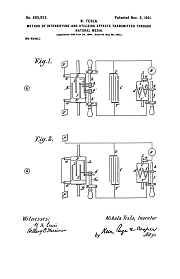
Angular Displacement Receivers
Tesla's Coherer Technology
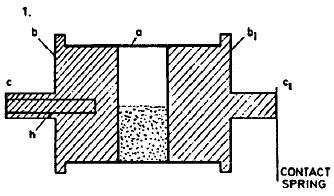
Wireless Communications Receivers
Tesla's Electrical Isochronous Oscillators
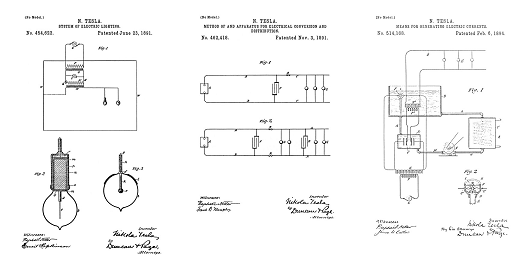
Capacitive Discharge Power Processing
Tesla's Electric Circuit Controllers
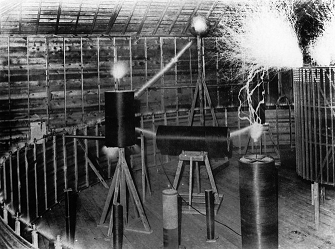
Precision Switching Technology
Tesla Fluid Model

Unified Field Mathematics
Mr. Tesla's Personal Exhibit at the World's Fair

Chapter XLII - The Martin Book
Tesla's Laboratory Power

Boiler, Steam Engine, Line-Shaft, Belts & Pulleys
The Inventions, Researches, and Writings of
Nikola Tesla


